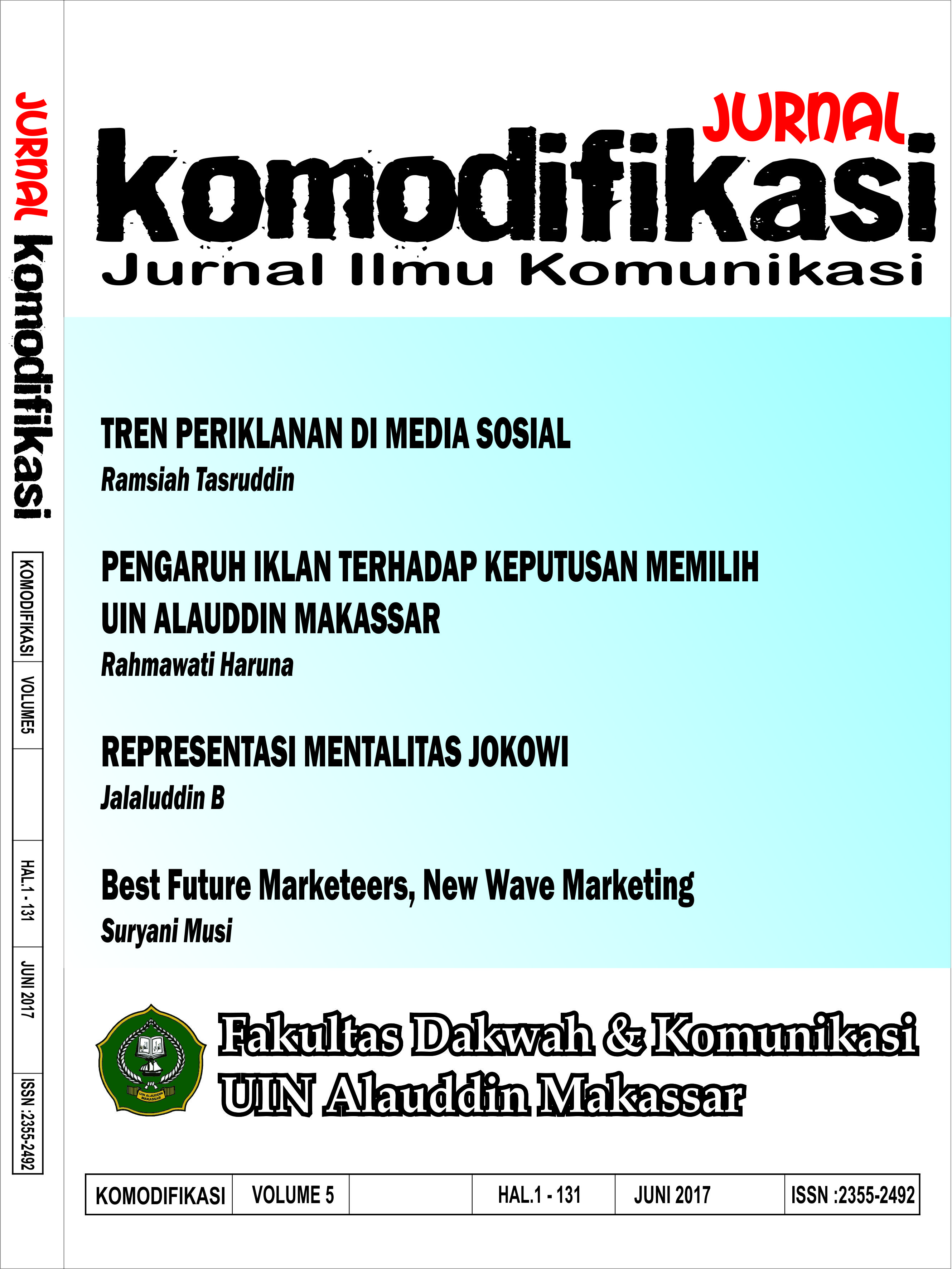REPRESENTASI KRITIK SOSIAL DALAM TAYANGAN STAND UP COMEDY INDONESIA (ANALISIS SEMIOTIKA DEKONSTRUKSI)
Abstract
This study entitled "Representation of Social Criticism in Display of Stand Up Comedy Indonesia (The Analysis Semiotics Deconstruction)". This study addresses two main issues, namely: (1) Representation of social criticism in stand-up comedy shows Indonesia. (2) The meaning of the representation of social criticism contained in stand-up comedy shows Indonesia. The purpose of this study was to determine how the representation of the social criticism in stand-up comedy, delivered and to know the meaning of the representation of social criticism in the stand-up comedy shows Indonesia. This study is an analysis of media texts by using a model of semiotic deconstruction of Jacques Derrida. Data collection techniques in this study is documentation techniques. Data analysis techniques in this study, carried out in three stages: description, analysis, and interpretation. The results showed that the material from Abdur within a few appearances in the competition stand up comedy Indonesia, the first preshow edition, Abdur - "Di-'Folbek 'Raditya Dika", show 4th "Handphone Sumber Kecelakaan", show 6th "Orasi dari Timur", and show 9th "Pe Es Ka Kupang". Born by the socio-cultural context behind it, namely: 1). The first preshow edition (Di-Folbek Raditya Dika) is motivated by the phenomenon of educational inequality that occurred in Indonesia, especially in the eastern part which gives the impression that the government "discriminates" and do not give good attention to education for children in eastern Indonesia; 2). 4th edition of the show (Handphone Sumber Kecelakaan) is motivated by the phenomenon than government services for people in underdeveloped areas that led to the development of the area is also slow. 3). 6th edition of the show (Orasi dari Timur) against the backdrop of the observation of Abdur against his apathetic society in electoral participation by large numbers vote. This issue made the government increasingly difficult to get connected with the people they lead. 4). Show 9th edition (Pe eS Ka Kupang) is based upon the phenomenon of inequality of development that occurred in Indonesia. Western Indonesia who continue to receive development funds large intake is inversely proportional to the effort to develop eastern Indonesia which is still very far from prosperous.
References
Buku
Ahmad, Hatta. Tafsir Qur’an Per Kata. Jakarta: Maghfirah Pustaka, 2010.
Berger, Charles, Michael E. Roloff dan David R. Roskos-Ewoldsen, The Handbook of Communication Science, Terj. Derta Sri Widowatie dan Zakkie M. Irfan, Handbook Ilmu Komunikasi. Bandung: Nusa Media, 2014.
Berger, Arthur Asa. Sign In Contemporary Culture: An Introduction to Semiotics, Terj. M. Dwi Marianto, Pengantar Semiotika: Tanda-Tanda dalam Kebudayaan Kontemporer. Yogyakarta: Tiara Wacana, 2010.
Damopolii, Muljono. Pedoman Penulisan Karya Tulis Ilmiah UIN Alauddin Makassar, (Edisi Revisi). Makassar: Alauddin Press, 2013.
Dean, Greg. Step by Step to Stand Up Comedy, Terj. Ernest Prakasa, Step by Step to Stand Up Comedy. Jakarta Selatan: Bukuné, 2012.
H. Hoed, Benny. Semiotik & Dinamika Sosial Budaya. Jakarta: Komunitas Bambu, 2011.
Harahap, Machyudin Agung. Kapitalisme Media. Yogyakarta: Aura Pustaka, 2013.
Listiyono, Santoso Dkk. Epistimologi Kir. Yogyakarta: Ar-Ruzz Media, 2007.
Noviani, Ratna. Jalan Tengah Memahami Iklan Antara Realitas, Representasi dan Simulasi. Yogyakarta: Pustaka Pelajar, 2002.
Nurudin, Pengantar Komunikasi Massa. Jakarta: PT. Rajagrafindo Persada, 2011.
Papana, Ramon. Kiat Tahap Awal Belajar Stand Up Comedy Indonesia (KITAB SUCI). Jakarta: Mediakita, 2012.
Piliang, Yasraf Amir. Hipersemiotika, Tafsir Cultural Studies Atas Matinya Makna, Bandung: Jalasutra, 2003.
Pragiwaksono, Pandji. Merdeka dalam Bercanda. Yogyakarta: Bentang, 2012.
Ratna, Nyoman Kutha. Teori, Metode, dan Tehnik Penelitian Sastra. Yogyakarta: Pustaka Pelajar, 2013.
Rusmana, Dadan. Filsafat Semiotika, Bandung: CV Pustaka Setia, 2014.
Hall, Stuart. Representation: Cultural Representations and Signifying Practices, London: SAGE Publications, 2003.
Sobur, Alex. Analisis Teks Media. Bandung: Remaja Rosdakarya, 2013.
Storey, John. Cultural Studies and the Study of Popular Culture, Terj. Layli Rahmawati dan Alfathri Adlin, Cultural Studies dan Kajian Budaya Pop. Yogyakarta: Jalasutra, 2010.
Syahputra, Iswandi. Rezim Media (Pergulatan Demokrasi, Jurnalisme, dan Infotainment dalam Industri Televisi). Jakarta: PT Gramedia Pustaka Utama, 2013.
Unde, Andi Alimuddin. Televisi dan Masyarakat Pluralistik. Jakarta: Prenadamedia Group, 2014.
Wahyu Wibowo, Indiwan Seto. Semiotika Komunikasi. Jakarta: Mitra Wacana Media, 2013.
Wirawan. Teori-Teori Sosial dalam Tiga Paradigma: Fakta Sosial, Defenisi Sosial, dan Perilaku Sosial. Cet. II; Jakarta: Kencana, 2013.
Yusuf Lubis, Akhyar. Dekonstruksi Epistimologi Modern. Jakarta: Pustaka Indonesia Satu, 2006.
Zaini, Akhmad. Kritik Sosial, Negara dan Demokrasi. Jakarta: Rajawali Press, 2010.
Internet:
Ar-Rahmah”. http://www.arrahmah.com/news/2014/04/13/golput-pemilu-2014-kekuatan-politik-laten. (10 November 2105).
Cirus Surveyor Group. Survey Penonton Stand Up Comedy. http://Cirus-sg.or.id, 10 April 2015.
Direktorat Jendral Pendidikan Tinggi. E-Journal,-Utari Dwi Rahma Sasmita- Hantisa Oksinata-Al Muhlas. (http://dikti.go.id/laman-portal/), 20 Januari 2015.
Juliastuti, Nuraini. Essai Dan Teori Representasi, (Jakarta: Februari 2011, http://kunci.or.id/esai/nws/04/representasi.htm.), 15 Februari 2015.
“Liputan6”. http://Liputan6.com/read/news/Kecelakaan_AQJ. 10 November 2015.
“Pemilihan Umum Presiden Indonesia”. Wikipedia. http://id.m.wikipedia.org/wiki/ Pemilihan _ Preseiden_ Indonesia_2014. 10 November 2014.
Sidiq, Priambodo. Sejarah Awal Berdirinya Stand Up Comedy di Dunia, (Bandung: Januari, 2103, http://sidiqpriambodo.blogspot.com), 20 januari 2015.
“Tempo.co”. http://m.tempo.co/read/news/2013/Data_Jumlah_Caleg_2014.
November 2014.
The Nielsen Global Survey of E-Commerce. Hasil Survei Pengaruh Media Massa di Masyarakat Indonesia. Jakarta: Desember 2014. http://www.nielsen.com/id/en/press-room/2014/survei-media-massa.
Maret 2015.
Tinangon, Meidy. http://pemilupemilukada.blogspot.co.id/2103/09/Surat-Suara-Pemilu-2104. 10 November 2014.

